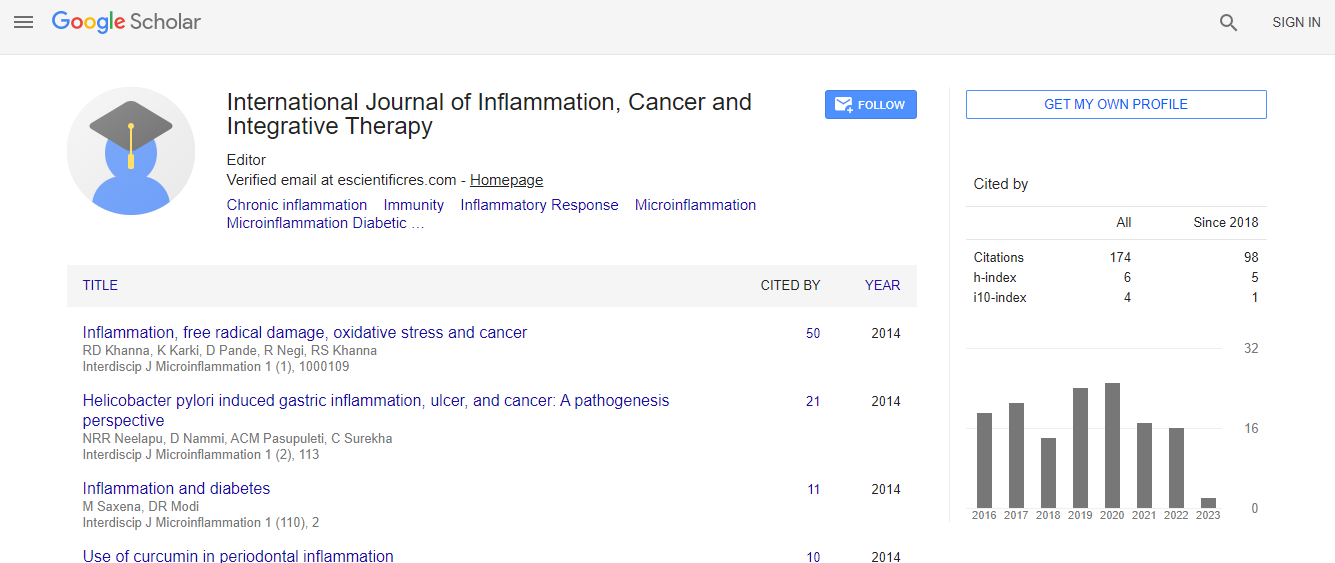Review Article
Inflammation, Free Radical Damage, Oxidative Stress and Cancer
Khanna RD1*, Karki K1, Pande D1, Negi R1 and Khanna RS21Department of Biophysics, Institute of Medical Sciences, Varanasi, India
2Department of Chemistry, Faculty of Science, Banaras Hindu University, Varanasi, India
- *Corresponding Author:
- Khanna RD
Professor Emeritus and Former Head
Department of Biophysics
Institute of Medical Sciences
Banaras Hindu University, Varanasi, India
Tel: 91-9450710446
Fax: 91-542-2367568
E-mail: hdkhanna@yahoo.co.in
Received date: August 29, 2014; Accepted date: July 24, 2014; Published date: July 26, 2014
Citation: Khanna RD, Karki K, Pande D, Negi R, Khanna RS (2014) Inflammation, Free Radical Damage, Oxidative Stress and Cancer. Microinflammation 1:109. doi: 10.4172/2381-8727.1000109
Copyright: © 2014 Khanna RD, et al. This is an open-access article distributed under the terms of the Creative Commons Attribution License, which permits unrestricted use, distribution, and reproduction in any medium, provided the original author and source are credited
Abstract
The health of our body is maintained by the equilibrium of Oxidation and Reduction. As long as a balance exists between oxidative stress and our antioxidant system, our body is maintained in a healthy state. However, excessive oxidative stress or inadequacy in a normal cell’s antioxidant defense system (or both) can cause the cell to experience oxidative stress. Tumor cells usually have an imbalanced redox status resulting in the damage to DNA, proteins and lipids. Higher levels of DNA damage and deficient DNA repair may predispose individuals to cancer. Reactive oxygen species (ROS) are involved in a variety of different cellular processes ranging from apoptosis and necrosis to cell proliferation and carcinogenesis. Molecular events, such as induction of cell proliferation, decreased apoptosis and oxidative DNA damage have been proposed to be critically involved in carcinogenesis. Carcinogenicity and aging are characterized by a set of complex end points, which appear as a series of molecular reactions. ROS can modify many intracellular signaling pathways including protein phosphatases, protein kinases and transcription factors suggesting that the majority of effect of ROS are through their actions on signaling pathways rather than via non- specific damage of macromolecules; however exact mechanism by which redox status induces cells to proliferate or to die, and how oxidative stress can lead to evoking tumor formation are still not clear. Our environment is oxidizing because of the prevalence of ambient Oxygen. The normal process of cellular metabolism, which requires oxygen from the air we breathe, leads to the production of free radicals- unstable, highly reactive molecules that lack an electron. Free radicals seek stability by stealing electrons from other stable molecules, creating a chain reaction of free radical formation that can cause damage to body cells, proteins and DNA. Aging and/or environmental stress may enhance this oxidative stress and may also lead to chronic inflammation, which can further exacerbate damage and increase cancer risk.

 Spanish
Spanish  Chinese
Chinese  Russian
Russian  German
German  French
French  Japanese
Japanese  Portuguese
Portuguese  Hindi
Hindi 
